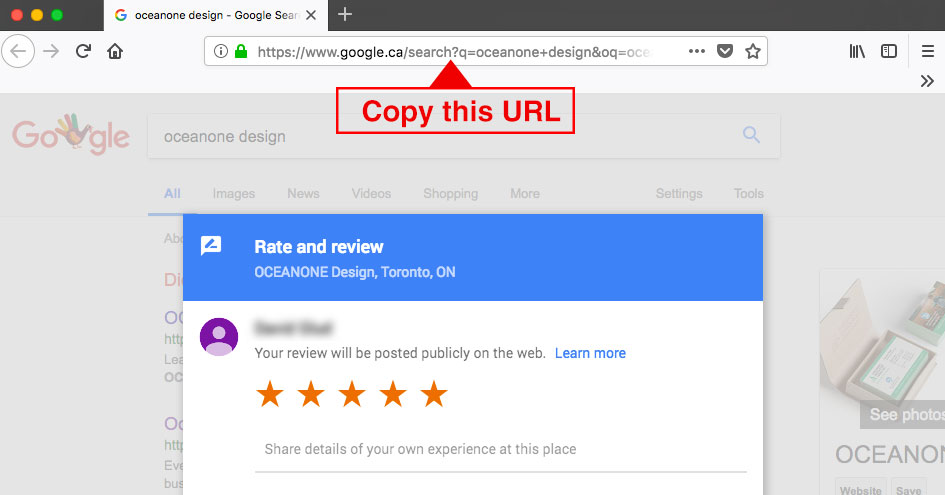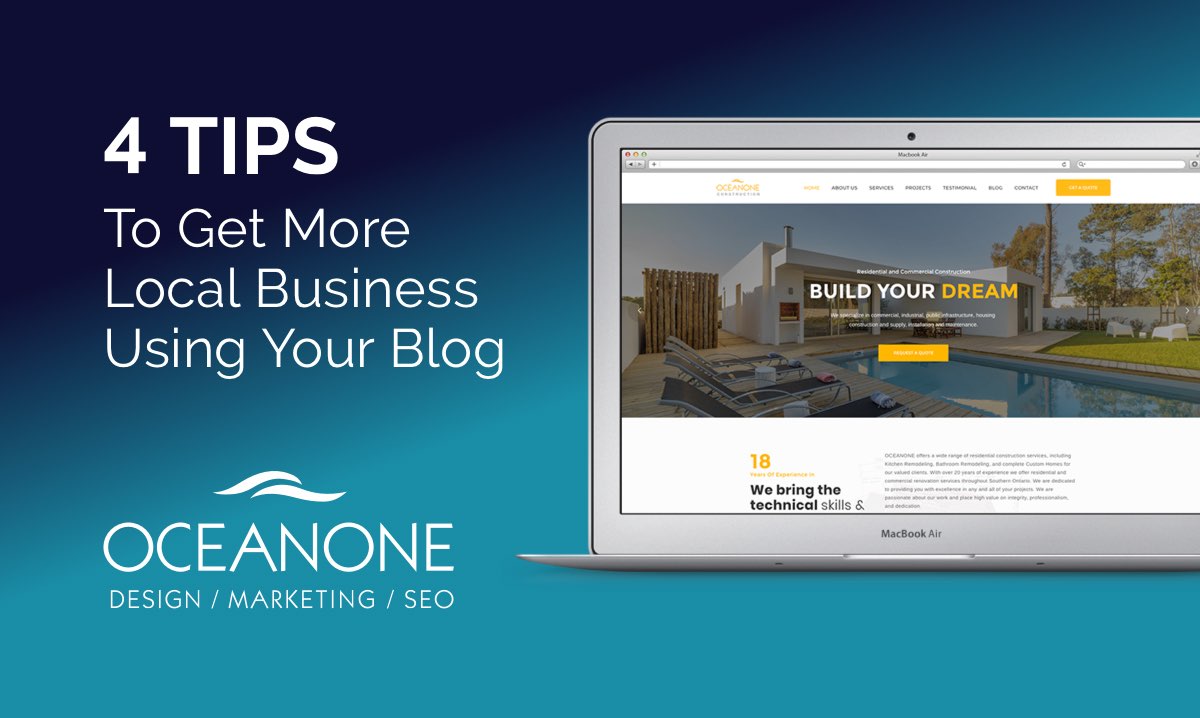
by DG | Oct 19, 2018 | SEO, Digital Marketing, Online Marketing
You should always think local when starting a Search Engine Optimization strategy. It’s much easier to rank for longtail keywords that have less competition. The name of your city or neighbourhood added to those keywords can be an easy win so you can rank quickly. That’s the best strategy to get started so let’s dig into Local SEO.
Key factors
First things first. Be sure to sign up on Google My Business (GMB). This will be the centre of your local strategy for getting rankings on Google. There may be a listing for your business there already so you’ll need to claim it. Do a Google search for your company name and you may see a listing for your business on the right side hand side in the search results. If you have not claimed it already you will see a “Claim this listing” button that will allow you to do so. Once you have access to your listing you will be able to add all kinds of information about your business and this will get him placed on Google maps as well. Be sure to upload lots of pleasing, relevant images for your business. You can great insights about your business listing in there like how many people viewed you listing and took action etc.
Writing Posts on Google My Business
We highly recommend that you create a post on your GMB listing everyday for at least 2 months. I know this sounds like a lot of work but it’s worth it and they only allow 300 words and you can back it off after your see your listing get into the top 3 local results for your keywords. Don’t stop completely though or competitors will eventually catch up. Try to keep posting at least once a week. This of course depends on how competitive your category is so you may need to adjust accordingly.
Add local content to your website
Blogging is the most effective way to help your rankings in search engine results. Write some blog posts that are unique to your local area and align with your local business. Doing some good keyword research prior to writing is articles will go along way. By doing so you can find out what people actually search for when they’re looking for your type of business in your area. For instance if you are a roofing company people might search for “toronto roofing company” (720 searches per month) but there are more searches for “toronto roofers” (1900 searches per month) so you should definitely have the data beforehand so that you can get the most out of your efforts. You can use Google Keyword Planner to get this data. Another new favourite free tool for keyword research is Ubersuggest from SEO expert Neil Patel.
Get listed on directories
Leveraging online directories is an excellent way to improve your online visibility. Claim any listings you can on sites like Yelp and Yellow Pages and other similar ones. Make sure all your profiles have the exact same contact information about your business. This is very important. You’ll also have to monitor these listings as many of them except reviews about your business. You need to stay on top of this and respond to reviews good or bad. Your online reputation is really important so I need to take this seriously.
We have a great tool to help you monitor this – checkout the OCEANONE Reputation Manager. And, if you don’t have the time we also provide a fully managed Reputation Management Service.
Here’s an excellent video on how to respond to reviews…
SEO Best Practices
Finally, be sure that you are using SEO best practices throughout your website. Things like properly formatted URLs and keyword rich descriptive title tags as well as descriptive metadata are important to make sure that Google’s algorithms pick up the best possible information about your page. Of course, make sure that your contact information on the website matches exactly what you added to all those directories you just listed on.
These are just a few things you can do to improve your visibility for local searches but they are the most important. Make sure these on-page improvements are done before taking any other steps. Depending on how competitive your category is, this might be all that you need to do to get the results you want. Start there and see how goes. If it’s not enough to get you in the top three local results there are other strategies. It’s not that complicated but it can be very time consuming.
If you don’t have the time, we can help. We have a Free listing builder app to get you started with getting your listing synced up on Google My Business, Facebook and Twitter. Once you have that set up you can easily add one of our paid packages that make it very easy to get listed on the sites we have discussed here. Learn more about it it out here.
Download our list of “Top 100 Sites To Be Listed On“. Our Listing Distribution add-on lets you build accurate business listings on the four major data aggregators—Factual, Acxiom, Infogroup, and Neustar Localeze. These aggregators are referenced by over 300 websites.
When multiple sources have consistent business data, two outcomes occur:
- Google’s WebCrawler finds the same information in multiple places and adds more confidence to their business data
- Good backlinks are created with more referring sources to the business’ website creating better SEO.
Here’s an excellent video on the importance of have accurate listings online…
Also check out our recent post “Online Reputation Management Tips for Boosting your Local SEO” .
If you already have listing and you have experienced Fake Reviews you’ll want to check out “How to remove “Google reviews when you know they are fake“.
It’s also important to get as many backlinks as you can in order to generate organic traffic. If you need help with that or any other SEO tasks, checkout our SEO services page.

by DG | Oct 12, 2018 | Digital Marketing, Business
Every business that has a presence online, would naturally want to be able to maintain a decent reputation. No business owner would want their business to generate negative reviews, which is why they always try to keep a keen eye on social media.
Online reputation management is the term that relates to this perusal of your brand’s reputation online. This term, like every other word related to SEO, has been thrown around quite a lot recently. So much so that brand managers now don’t really know to expect from online reputation management. This brings us to the question of what exactly is online reputation management.
Is it a proven method of maintaining your reputation and local SEO online, or is it just a buzzword? Can it really help you with your reputation online?
We answer these questions and many more in the lines below, by taking a look at the nuances involved in online reputation management, and how it can positively boost your Local SEO.
What is Online Reputation Management?
For starters, online reputation management is perhaps one of the best ways to enhance your presence online. At a layman level this practice relates to studying what people are saying about you, and trying to handle their problems. There’s hardly any business out there that doesn’t have issues arising with customers. While you would ideally prefer to have the issue resolved before the customer takes the matter online, that is usually not the case.
Customers share bad experiences online, and these bad experiences act as a deterrent for other potential customers coming your way. However, you can manage these online complaints through your online reputation management system.
When dealing with negative reviews it is important write a response as soon as possible, be polite, courteous and professional. NEVER be defensive. Try to understand their problem and offer to resolve the problem even if you think they are being ridiculous. You will never come out ahead if you try argue with them.
Here we will list down some amazing tips that you can follow to enhance the utility of your online reputation management system and maintain your Local SEO online while at it.
Be Present on all Web Portals
Social media is a must for every brand. It is best for your brand to be up on social media to not only interact with potential customers, but to also listen to their grievances. A company should have a Facebook, Twitter and Google+ account at least. You can further have an Instagram, Snapchat and other social media accounts to reach out to your customers through new channels.
Now, the journey to excellent reputation management online doesn’t stop with the creation of accounts on multiple social media platforms. The real effort lies in regularly regulating and reviewing these accounts. The worst that can happen for your brand is an online review or complaint by a customer that you haven’t addressed.
This negligence on your part would not just turn that one customer away from you, but would also leave a bad impression on others. Thus, the way forward is to review these accounts and all the complaints that come on them.
Local Listings Establish Your Presence
Search engines use complex algorithms to ensure that the information they are giving out is reliable and can be trusted. As part of this, they cross-reference company information from local listings present across the web to generate information related to your phone numbers, map pointers, email addresses, postal addresses and opening and closing times. Based on concrete evidence generated through these methods, a search engine gives out the required information to your customers.
Now, if your information across multiple local listings is not updated, your local SEO campaign will suffer due to this incorrect information. Search engines will direct customers to wrong addresses and might even give old numbers. To cut out the chances of this happening, ensure that all information pertaining to your company on local listings is updated so that search engines can reference the correct source.
Build a Profile of High Quality Local Reviews
User generated content is still content, and pretty successful at it. Individual reviews might not be able to generate the same impact as a blog or a video for that matter, but by building a profile of good reviews across social media and the internet, you can boost your local SEO.
Having potentially good information associated to your brand, from organic third parties, on highly trustworthy review and social media sites, gives your Local SEO the boost it needs. These valuable reviews give search engines quite a lot of contextual information about you, which they can use to rank your company locally.
Social Proof
Believe it or not, but search engines, including Google, tend to rank local companies with better reviews higher than others that have negative reviews or no reviews at all. This is a tried and tested method by these engines to take social proof as a performance of brands.
For example, Google usually takes a look at reviews coming on its own Google My Business platform, and from other partners that their algorithms trust, including Yelp and Facebook. Based on the information from this analysis, Google’s algorithms develop the social standing of a specific organization in its local setting. The social standing includes answers to questions such as, is the company well-liked and popular? Is there sufficient evidence to suggest that the company gives bad experiences and customer services? Then, based on star ratings and reviews, Google takes the ultimate decision of how suitable your brand is for a searcher’s query.
Make the Investment
Finally, you need to make a sufficient investment to get the best out of your online reputation management plan. Reputation development often requires investment both in the form of time and money. You will obviously need dedicated members to monitor your reputation online and generate results based on that.
Other than that, there is also the need for investment in catering to customer grievances. A simple apology doesn’t make the cut anymore. You would need something along the lines of a giveaway to win their trust again, and use that complaint as a means to leverage your reputation online.
Proactive reputation management might take some time and effort while setting up, but it is a worthy investment that will definitely pay off in the long run.
BONUS TIP – Make it easier for people to leave a Google review.
Here are steps to make it easier for people to leave a Google review about your business :
- Search for your company by name in Google.
- Click on the button “Write a review”.
- A Google review box has pops up, click away for the popup window and copy the URL from the address bar.
- Shorten the URL. The URL will be very long. Use a URL shortener like bit.ly to get a nice sort URL that you can share with people.
Here an example of ours – Click To Review: https://bit.ly/2PhcT7b
We hope these tips will be helpful. If you don’t have the time to deal with all this we do have Reputation Management Services to take care of it for you. It will help with your Local SEO efforts.
Also check our article about dealing with Fake Reviews. as well as Neil Patel’s Definitive Guide to Online Reputation Management.

by DG | Oct 8, 2018 | Branding, Digital Marketing
Fake reviews are an unfortunate reality that many businesses have to deal with.
It’s so easy for people to create a new anonymous account and leave a review that is positive or negative. The worst part is that it doesn’t matter if they are a customer or not, they are free to leave a review and say whatever they like. So what do you do when you want to remove Google reviews?
Before we go further I’ll just say that when dealing with negative reviews that are real it is important write a response as soon as possible, be polite, courteous and professional. DO NOT ever be defensive. Try to understand their problem and offer to resolve the problem.
The rest of this post is about dealing with reviews that you know are fake. I get asked about this often so let’s get to it…
Google Policies
Google has a huge list of policies around this topic but they do not do a very good job of catching policy violations. There is hope however! If you can track these fake reviews and make a case as to why the review is violating Google’s policy guidelines you can get them removed. To do so you can contact them through Facebook, Twitter or on the Google My Business forum.
When you are logged in to GMB find the review that you believe is a fake. You will see three dots stacked on top of one another, click those. Then you will see the option to “flag as inappropriate.” Fill out the form and that’s it. You can also expedite the process by calling GMB support. You will find their support number within your GMB account.
Why won’t Google remove that fake review?
If you can’t show that the reviewer has made a policy violation, they won’t remove the review. The most difficult reviews to get rid of are the ones with 1 star and no comments. Google’s response will likely be that it didn’t violate the guidelines — since there’s no text in the review. Personally I think that reviews without comments should not be accepted by Google – call me crazy – I guess it’s it too much to ask!
If the review is completely off-topic and complaining about a service you don’t even offer then you will most certainly be able to get it removed by Google.
What do you when Google won’t remove that fake review.
The huge problem with fake negative reviews is that Google doesn’t know your customers. Therefore, telling them that the person leaving a review is not an actual customer is not a strong enough case to get that review removed. If the reviewer is anonymous it’s very difficult to prove their identity.
Another problem is that they might not have been a customer. They are eligible to leave a review even if they just called you and you didn’t return their voicemail. Maybe you have a store and they couldn’t find parking… Oh yeah, it’s hard to make everyone happy.
Most small businesses bend over back wars to keep customers satisfied and you just know when you have an unhappy customer so when there’s a fake review, you can just smell it. It seems out of place and it seems to come out of nowhere.
Like I said, sometimes Google just won’t remove it, then what, should you just leave it sitting there?
Absolutely not, there are some strategies to deal with it. Encouraging your satisfied customers is of course one of the ways to help bring up your rating average. However that fake review is still festering and annoying you to no end.
What’s the best way to deal with a fake negative review that Google won’t remove?
Challenge that Faker! Be polite by writing a response something like: “We are quite certain that [username] is not a customer of ours. In fact we are so certain that we would like to offer a 100% refund if you send us the receipt from the gmail account you used to write this review.”
Give them a few days to respond. If they don’t respond to that, then you know it’s a fake review and you should update your review response.
Update your response with something like: “After waiting 1 week for a reply to our 100% refund offer we never got a response. Sadly, it is likely from one of our competitors engaging in the writing of fake reviews for their own gain.”
If by some miracle you are wrong and the review was real, they may send you a receipt. If their reasoning for the complaint is legitimate, then you might want to refund them and in return ask them to delete the review. It’s probably worth it for your business and you have learned something. You might also be able to settle it by fixing the problem that they have complained about.
USEFUL TIP – Make it easier for people to leave a Google review.
To make it easier for people to leave a positive Google review about your business, follow there steps:
- Search for your company by name in Google.
- Click on the button “Write a review”.
- A Google review box has pops up, click away for the popup window and copy the URL from the address bar (see image below).
- The URL will be very long. Use a URL shortener like bit.ly to get a nice short URL that you can share with people.

Here an example of ours – Click to review: https://bit.ly/2PhcT7b
We hope these tips will be helpful. We have a Reputation Management App to help you get control of your reviews. If you don’t have the time to deal with all this, we do have Reputation Management Services to take care of it for you.
Beyond Google
We have focused entirely on getting reviews on your Google My Business page in this post but you should of course not ignore other review sites, Google should be your prime focus though. There are many other review sites that you can benefit from like Yelp, Yahoo Local, Trip Advisor, Trust Link, Trust Pilot etc.
The more you list on, the more you will help build trust for your business, and boosting your local search rankings at the same time.
Have you experienced fake reviews? If have, we would love to hear about it, please leave a comment.

by DG | Nov 12, 2021 | Content Marketing, Digital Marketing, Online Marketing, SEO
Updated: Nov, 12, 2021
You are likely well aware of the concept of content marketing by now. It’s a tactic that helps you engage and attract customers and prospects by delivering quality content that provides value for everyone who visits your site. And the strategy has a lot of staying power.
Here are just a few areas in which content marketing can help you.
Driving Conversion
A great benefit of content marketing is that it helps your company drive more conversions over time. Research shows that companies that create consistent marketing content experience conversion rates almost six times higher than their competitors.
Increasing Traffic and Brand Awareness
Publishing consistent blog posts that engage audiences will help you bring in more traffic to your site over time. According to HubSpot, companies that published more than 16 blog posts per month got almost three and a half times more traffic than those that only published fewer than four posts.
It also helps educate people about your brand and raises the level of brand awareness that is otherwise not there when you don’t publish blog posts outlining what your company does or sells.
Check out our Pro Blogging Packages
Building trust and Fostering Relationships
You can build real relationships with your customers through content driven marketing. It allows customers to really absorb your philosophy and thinking patterns and associate themselves with your values. This allows them to take a peek in to the way that your company does business. It’s a lot more personal and less presumptuous than an advertisement.
Building Credibility and Expertise
Well written and polished content automatically comes across as professional and authoritative. It allows people to see your company as an expert or an authority on the subject of your business. It also allows you to be seen as a major player in the industry.
Cost Effectiveness and SEO Visibility
According to the Content Marketing Institute, content marketing costs 62% less than outbound marketing even though it generates three times as many leads. It also helps your company and topics trend better in search engines, specifically Google. Allowing your content to trend well allows for greater visibility.
Targeting Specific Audiences
It’s important to know exactly who you’re selling to when you’re selling a product or a service. For this reason, content driven marketing is useful to get your message across to your target demographic. It sounds extremely cold and calculating, but it’s useful without a doubt.
Engaging Content Makes a Personal Connection
As outlined above, it’s more engaging and personal than an advertisement. The written word, when written well has a much better connection with your readers and customers than an ad ever can, hence, the emphasis on content driven marketing.
Can bring you Unexpected Customers
It’s incredible that content marketing can bring you customers from so many different places that are not your target demographic. You can use trends and current hot topics to market your products or services to people that won’t normally look twice in your direction.
Do you need great content for your website? As on of the top small business branding agencies, we have great writers standing by that can produce excellent, affordable content on any topic. Check out our packages.
It’s also important to get as many backlinks as you can in order to generate organic traffic. If you need help with that or any other SEO tasks, checkout our SEO services page.

by DG | Oct 1, 2018 | Content Marketing
Updated Oct, 4, 2019
Using blogs and other social media can be very effective for getting more local business. Most people think of social networking as only a way to drive global traffic. However, it can be used very effectively for getting local business as well. Here are four tips to make it work:
#1) Target local keywords
This can seem somewhat limiting, because you can only targeted “area specific” keywords but if you’re a local service business it’s the way to go. There is no sense in trying to compete with the whole world for a keyword like “carpenter” when you do all you business within a 100 mile radius. If you wrote a book or sell tools related to “carpenter” then that is of course a whole different story. Then maybe you want to be able to sell globally and it’s worth the expense to compete beyond your borders.
#2) Use social media sites
Getting involved in social media sites like Facebook and Twitter is a great strategy to get more people to your blog. When used right, they can be very effective.
How do you use them correctly?
You have to get involved in the community and answer people’s questions. People won’t buy from you until they know that you are really interested in helping them. If they can tell that you only care about your wallet, they will avoid you.
Therefore, you want to get involved and answer people’s questions without expecting anything in return. When you do this, you build up the trust factor. When people realize you really want to help them, they will then purchase your products.
Many people just go to social media sites and start spamming them by putting a bunch of links to their website. By doing this you are not contributing anything to the community and not providing no real value. This won’t work in the long run.
#3) Provide value
You want to use the social media sites to get people to come to your blog. Once you get people to your blog, you have to convert that traffic into sales.
This is where a lot of marketers mess up.
Most bloggers fail to profit because they have boring posts. It’s important not to make every post a sales pitch, you need to contribute and provide value by giving free information. It proves your authority on the topic and builds trust.
OCEANONE Design – one of the Top Small Business Web Design Companies in DesignRush. See the designrush agency listings.
#4) Tell a story
It’s been proven time and time again that the more value you deliver, the more you will profit. You also want to deliver that value in an interesting and exciting way.
One of the best ways to do this is to tell a story. People are interested in stories so they will be more engaged. So if you make your marketing about your own life, you will see better results. More personality in marketing = better results.
The bottom line is, using social media can be very effective for local advertising. Implement these four tips, and your profits will increase substantially.






